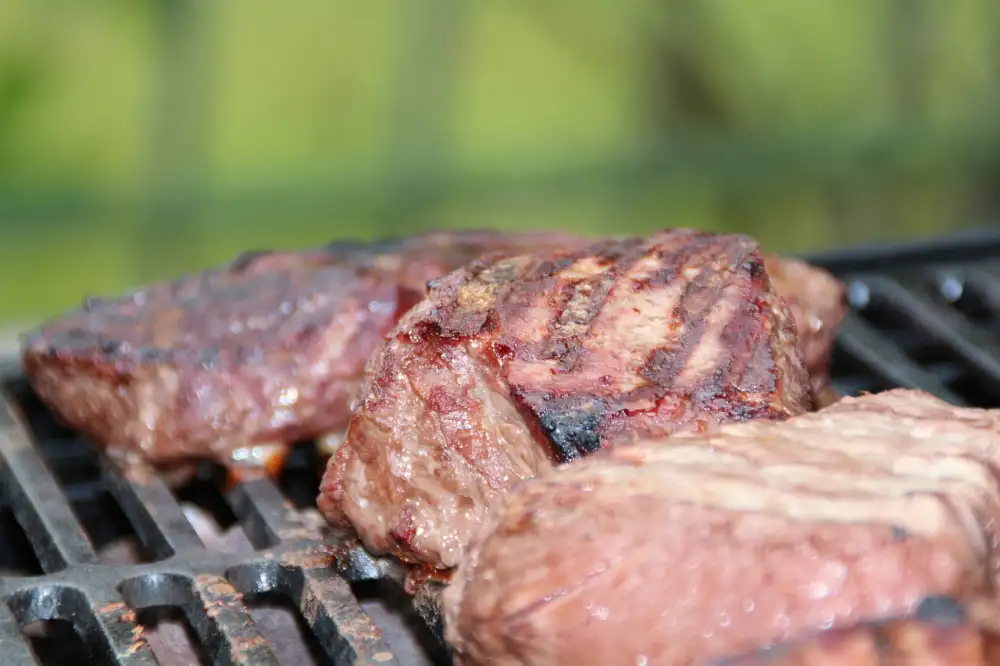Perfectly Grilled Steak: Mastering the Art of Timing for Juicy Results

- Preparing the steak for grilling
- Determining the steak's thickness
- Calculating the grilling time based on thickness
- Preheating the grill
- Placing the steak on the grill
- Flipping the steak halfway through cooking
- Checking the steak for doneness
- Resting the steak before serving
- Tips for achieving the perfect grilled steak
Grilling steak is a popular cooking method that brings out the rich flavors and juicy tenderness of the meat. Whether you're a novice or an experienced cook, mastering the art of grilling steak can take your culinary skills to the next level. Grilling allows for the perfect balance of smoky char and succulent meat, creating a mouthwatering dish that is sure to impress. In this article, we will guide you through the process of grilling steak, from preparation to serving, so you can achieve perfectly grilled results every time. So fire up your grill and get ready to elevate your steak game!
Preparing the steak for grilling
Preparing the steak for grilling is an essential step to ensure a delicious and juicy result. Start by taking the steak out of the refrigerator and allowing it to come to room temperature for about 30 minutes. This will help it cook more evenly. Next, pat the steak dry with paper towels to remove any excess moisture. Season the steak generously with salt and pepper, or your favorite seasoning blend, on both sides. For added flavor, you can also marinate the steak in your choice of marinade for a few hours or overnight in the refrigerator. Just remember to discard any leftover marinade that has come into contact with raw meat to prevent cross-contamination. By properly preparing your steak before grilling, you are setting yourself up for a mouthwatering meal.
Determining the steak's thickness
Determining the steak's thickness is crucial for achieving the perfect grilled steak. To do this, use a ruler or a tape measure to measure the steak from top to bottom. The thickness of the steak will determine the cooking time needed to achieve your desired level of doneness. Thicker steaks will require longer cooking times, while thinner steaks will cook more quickly. It's important to note that the cooking time will also depend on the heat of your grill, so be sure to adjust accordingly. Once you have determined the thickness of your steak, you can move on to calculating the grilling time based on this measurement.
Calculating the grilling time based on thickness
Calculating the grilling time based on the thickness of your steak is crucial for achieving perfectly cooked results. As a general rule, you should allow about 4-5 minutes of grilling time per half-inch of thickness for medium-rare doneness. For example, if your steak is 1 inch thick, you would grill it for approximately 8-10 minutes. Keep in mind that thicker steaks will require longer cooking times, while thinner steaks will cook more quickly. It's important to adjust the cooking time accordingly to avoid undercooking or overcooking your steak.
Preheating the grill
Preheating the grill is a crucial step in achieving the perfect grilled steak. It ensures that the grill reaches the optimal temperature for searing and cooking the meat evenly. To preheat, turn on all burners to high heat and close the lid. Allow the grill to heat up for at least 10-15 minutes, or until it reaches a temperature of around 450-500°F (230-260°C). This high heat will create those beautiful grill marks and lock in the juices of the steak. Remember, a properly preheated grill is key to achieving juicy and flavorful results.
Placing the steak on the grill
Placing the steak on the grill is a crucial step in achieving a perfectly grilled steak. Once your grill is preheated to the desired temperature, carefully place the steak directly onto the hot grates. Be sure to position it at a slight angle to create those beautiful grill marks. Avoid overcrowding the grill, as this can prevent even cooking and result in less juicy steaks. Allow each side of the steak to cook undisturbed for the calculated grilling time, resisting the temptation to constantly flip or move it around. Remember, patience is key when it comes to grilling steak!
Flipping the steak halfway through cooking
Flipping the steak halfway through cooking is a crucial step in achieving a perfectly grilled steak. This ensures that both sides of the steak are evenly cooked and allows for a beautiful sear on each side.
To flip the steak, use a pair of tongs or a spatula to carefully lift and turn it over. Be gentle to avoid piercing the meat and losing its precious juices.
Timing is key when flipping the steak. For thinner cuts, such as ribeye or sirloin, flip after about 3-4 minutes of grilling on the first side. Thicker cuts like T-bone or porterhouse may need around 5-6 minutes before flipping.
Remember, flipping too early can result in an undercooked steak, while flipping too late can lead to overcooking. So keep an eye on the timer and be ready to flip at just the right moment.
Once you've flipped the steak, continue grilling for another 3-4 minutes (or 5-6 minutes for thicker cuts) on the second side. This will ensure that both sides are cooked to perfection and develop a delicious crust.
By mastering the art of flipping at the right time, you'll be able to achieve that coveted grill marks and maximize flavor in every bite of your juicy grilled steak.
Checking the steak for doneness
Checking the steak for doneness is crucial to ensure that it is cooked to your desired level of doneness. There are a few methods you can use to determine if your steak is cooked perfectly. One popular method is using a meat thermometer. Insert the thermometer into the thickest part of the steak, avoiding any bones or fat. For medium-rare, look for a temperature of around 135°F (57°C), while medium should be around 145°F (63°C). Another method is the finger test. Gently press the center of the steak with your index finger and compare its firmness to different parts of your hand. A rare steak will feel soft like the base of your thumb, medium-rare will feel slightly firmer like the fleshy part below your thumb, and medium will feel firm like the base of your palm. Remember that these are just guidelines and practice will help you develop a better sense of doneness.
Resting the steak before serving
Resting the steak before serving is a crucial step in ensuring a juicy and flavorful result. After grilling, it's tempting to dig right into that sizzling piece of meat, but patience is key. Resting allows the juices to redistribute throughout the steak, resulting in a more tender and succulent bite.
To rest the steak, simply remove it from the grill and place it on a cutting board or plate. Tent it loosely with aluminum foil to keep it warm. Letting the steak rest for about 5-10 minutes will allow the muscle fibers to relax and retain their moisture.
During this resting period, you can use the time to prepare any accompanying side dishes or sauces. This also gives you an opportunity to gather your guests or set the table for an impressive presentation.
Remember, don't rush this step! Resting ensures that all your efforts in grilling are rewarded with a perfectly cooked steak that will impress even the most discerning palates. So resist the urge to cut into it immediately and let your steak rest before serving for optimal results.
Tips for achieving the perfect grilled steak
1. Use a high-quality cut of meat: Choose a well-marbled steak, such as ribeye or striploin, for maximum flavor and tenderness.
2. Season generously: Rub the steak with a mixture of salt, pepper, and any other desired spices to enhance its natural flavors.
3. Let the steak come to room temperature: Take the steak out of the refrigerator at least 30 minutes before grilling to ensure even cooking.
4. Oil the grill grates: Prevent sticking by brushing the grill grates with oil before placing the steak on them.
5. Don't overcrowd the grill: Leave enough space between each steak to allow for proper heat circulation and avoid steaming instead of grilling.
6. Avoid excessive flipping: Only flip the steak once during cooking to develop a nice crust and retain juices.
7. Use a meat thermometer: Invest in a reliable meat thermometer to accurately determine when your steak is cooked to your desired level of doneness.
8. Let it rest: After removing from the grill, let the steak rest for about 5 minutes before slicing to allow juices to redistribute and ensure maximum tenderness.
9. Experiment with marinades and sauces: Enhance your grilled steak's flavor profile by marinating it beforehand or serving it with a delicious sauce on the side.
10. Practice makes perfect: Grilling steak is an art that takes time and practice to master, so keep experimenting and refining your technique for consistently juicy results.
In conclusion, mastering the art of timing is essential for achieving a perfectly grilled steak. By following the steps outlined in this article, you can ensure that your steak is juicy and cooked to perfection every time. Remember to properly prepare the steak, determine its thickness, calculate the grilling time, preheat the grill, and flip the steak halfway through cooking. Don't forget to check for doneness and allow the steak to rest before serving. With these tips in mind, you'll be well on your way to becoming a grilling expert and impressing your friends and family with delicious grilled steaks. Happy grilling!
Published: 08. 12. 2023
Category: Recipes



